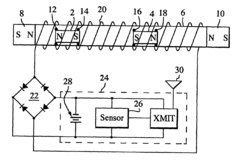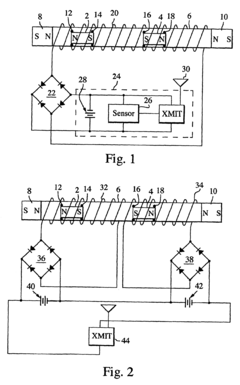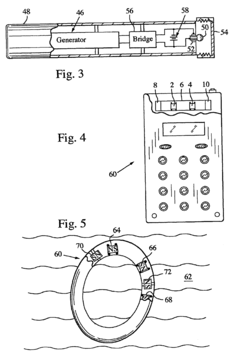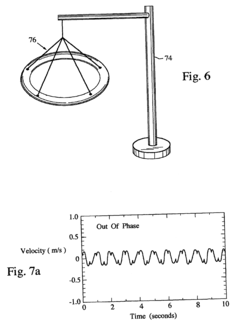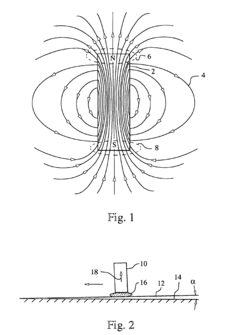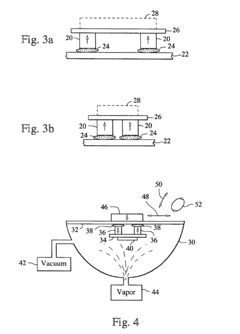Ferrofluid's Contribution to Low-Loss Magnetic Bearings
JUL 9, 20259 MIN READ
Generate Your Research Report Instantly with AI Agent
Patsnap Eureka helps you evaluate technical feasibility & market potential.
Ferrofluid Bearings: Background and Objectives
Ferrofluid bearings represent a significant advancement in the field of magnetic bearing technology, combining the principles of magnetism and fluid dynamics to create low-friction, high-performance bearing systems. The development of ferrofluid bearings can be traced back to the 1960s when ferrofluids were first synthesized and their unique properties were discovered. These colloidal suspensions of magnetic nanoparticles in a carrier fluid exhibit both magnetic and fluid characteristics, making them ideal for use in bearing applications.
The evolution of ferrofluid bearing technology has been driven by the increasing demand for more efficient and reliable bearing systems in various industries, including aerospace, precision machinery, and energy production. Traditional mechanical bearings often suffer from wear, friction, and the need for regular maintenance, while conventional magnetic bearings require complex control systems and high power consumption. Ferrofluid bearings aim to address these limitations by offering a hybrid solution that combines the benefits of both fluid and magnetic bearings.
The primary objective of ferrofluid bearing research and development is to create a bearing system that minimizes energy losses while maximizing load capacity and stability. By utilizing the unique properties of ferrofluids, researchers aim to achieve near-zero friction, self-centering capabilities, and enhanced damping characteristics. These features are particularly crucial in applications requiring high-precision positioning, such as in semiconductor manufacturing equipment or advanced scientific instruments.
Another key goal in the development of ferrofluid bearings is to overcome the challenges associated with traditional magnetic bearings, such as the need for active control systems and high-power electromagnets. Ferrofluid bearings have the potential to provide passive stability and reduced power consumption, making them an attractive option for a wide range of applications, from small-scale devices to large industrial machinery.
The technological trajectory of ferrofluid bearings is closely linked to advancements in materials science, particularly in the synthesis and optimization of ferrofluids. Researchers are continually working to improve the magnetic properties, thermal stability, and longevity of ferrofluids to enhance their performance in bearing applications. Additionally, efforts are being made to develop more effective sealing mechanisms to prevent ferrofluid leakage and contamination, which are critical factors in ensuring the long-term reliability of ferrofluid bearings.
As the field progresses, there is a growing focus on integrating ferrofluid bearings with smart materials and adaptive control systems to create next-generation bearing solutions. These advanced systems aim to provide real-time monitoring and adjustment capabilities, further improving the performance and reliability of ferrofluid bearings across a diverse range of operating conditions and environments.
The evolution of ferrofluid bearing technology has been driven by the increasing demand for more efficient and reliable bearing systems in various industries, including aerospace, precision machinery, and energy production. Traditional mechanical bearings often suffer from wear, friction, and the need for regular maintenance, while conventional magnetic bearings require complex control systems and high power consumption. Ferrofluid bearings aim to address these limitations by offering a hybrid solution that combines the benefits of both fluid and magnetic bearings.
The primary objective of ferrofluid bearing research and development is to create a bearing system that minimizes energy losses while maximizing load capacity and stability. By utilizing the unique properties of ferrofluids, researchers aim to achieve near-zero friction, self-centering capabilities, and enhanced damping characteristics. These features are particularly crucial in applications requiring high-precision positioning, such as in semiconductor manufacturing equipment or advanced scientific instruments.
Another key goal in the development of ferrofluid bearings is to overcome the challenges associated with traditional magnetic bearings, such as the need for active control systems and high-power electromagnets. Ferrofluid bearings have the potential to provide passive stability and reduced power consumption, making them an attractive option for a wide range of applications, from small-scale devices to large industrial machinery.
The technological trajectory of ferrofluid bearings is closely linked to advancements in materials science, particularly in the synthesis and optimization of ferrofluids. Researchers are continually working to improve the magnetic properties, thermal stability, and longevity of ferrofluids to enhance their performance in bearing applications. Additionally, efforts are being made to develop more effective sealing mechanisms to prevent ferrofluid leakage and contamination, which are critical factors in ensuring the long-term reliability of ferrofluid bearings.
As the field progresses, there is a growing focus on integrating ferrofluid bearings with smart materials and adaptive control systems to create next-generation bearing solutions. These advanced systems aim to provide real-time monitoring and adjustment capabilities, further improving the performance and reliability of ferrofluid bearings across a diverse range of operating conditions and environments.
Market Analysis for Low-Loss Magnetic Bearings
The market for low-loss magnetic bearings has been experiencing significant growth in recent years, driven by the increasing demand for high-performance, energy-efficient machinery across various industries. These bearings offer numerous advantages over traditional mechanical bearings, including reduced friction, lower maintenance requirements, and improved operational efficiency.
The global magnetic bearings market is primarily segmented into active and passive magnetic bearings, with active magnetic bearings dominating the market due to their superior performance characteristics. Key application areas include turbomachinery, compressors, pumps, and generators, spanning industries such as oil and gas, power generation, aerospace, and semiconductor manufacturing.
The adoption of low-loss magnetic bearings has been particularly strong in the energy sector, where the need for high-speed, high-efficiency rotating equipment is paramount. In the oil and gas industry, magnetic bearings are increasingly used in gas turbines and compressors, offering improved reliability and reduced downtime. The power generation sector has also seen a surge in demand, with magnetic bearings being integrated into advanced turbine designs for enhanced energy efficiency.
The aerospace industry represents another significant market for low-loss magnetic bearings, with applications in aircraft engines, auxiliary power units, and environmental control systems. The ability of magnetic bearings to operate in extreme conditions and their potential for weight reduction make them particularly attractive for aerospace applications.
Market growth is further fueled by the ongoing trend towards Industry 4.0 and the increasing focus on predictive maintenance. The integration of sensors and advanced control systems in magnetic bearings allows for real-time monitoring and diagnostics, aligning well with the principles of smart manufacturing and industrial IoT.
Geographically, North America and Europe currently lead the market for low-loss magnetic bearings, owing to their advanced industrial infrastructure and strong presence of key manufacturers. However, the Asia-Pacific region is expected to witness the highest growth rate in the coming years, driven by rapid industrialization, increasing energy demands, and growing investments in high-tech manufacturing.
Despite the positive market outlook, challenges remain in the widespread adoption of low-loss magnetic bearings. These include high initial costs, the need for specialized expertise in installation and maintenance, and concerns about long-term reliability in certain applications. However, ongoing research and development efforts, particularly in the field of ferrofluid-enhanced magnetic bearings, are addressing these challenges and expanding the potential applications of this technology.
The global magnetic bearings market is primarily segmented into active and passive magnetic bearings, with active magnetic bearings dominating the market due to their superior performance characteristics. Key application areas include turbomachinery, compressors, pumps, and generators, spanning industries such as oil and gas, power generation, aerospace, and semiconductor manufacturing.
The adoption of low-loss magnetic bearings has been particularly strong in the energy sector, where the need for high-speed, high-efficiency rotating equipment is paramount. In the oil and gas industry, magnetic bearings are increasingly used in gas turbines and compressors, offering improved reliability and reduced downtime. The power generation sector has also seen a surge in demand, with magnetic bearings being integrated into advanced turbine designs for enhanced energy efficiency.
The aerospace industry represents another significant market for low-loss magnetic bearings, with applications in aircraft engines, auxiliary power units, and environmental control systems. The ability of magnetic bearings to operate in extreme conditions and their potential for weight reduction make them particularly attractive for aerospace applications.
Market growth is further fueled by the ongoing trend towards Industry 4.0 and the increasing focus on predictive maintenance. The integration of sensors and advanced control systems in magnetic bearings allows for real-time monitoring and diagnostics, aligning well with the principles of smart manufacturing and industrial IoT.
Geographically, North America and Europe currently lead the market for low-loss magnetic bearings, owing to their advanced industrial infrastructure and strong presence of key manufacturers. However, the Asia-Pacific region is expected to witness the highest growth rate in the coming years, driven by rapid industrialization, increasing energy demands, and growing investments in high-tech manufacturing.
Despite the positive market outlook, challenges remain in the widespread adoption of low-loss magnetic bearings. These include high initial costs, the need for specialized expertise in installation and maintenance, and concerns about long-term reliability in certain applications. However, ongoing research and development efforts, particularly in the field of ferrofluid-enhanced magnetic bearings, are addressing these challenges and expanding the potential applications of this technology.
Ferrofluid Technology: Current State and Challenges
Ferrofluid technology has made significant strides in recent years, particularly in its application to low-loss magnetic bearings. However, several challenges persist in fully realizing its potential. The current state of ferrofluid technology is characterized by a delicate balance between its unique properties and the limitations that hinder widespread adoption.
One of the primary challenges is the long-term stability of ferrofluids. While these smart materials exhibit remarkable responsiveness to magnetic fields, maintaining their colloidal stability over extended periods remains problematic. Factors such as temperature fluctuations, oxidation, and particle agglomeration can degrade the ferrofluid's performance over time, affecting the reliability of magnetic bearing systems.
Another significant hurdle is the precise control of ferrofluid behavior under varying operational conditions. The complex interplay between magnetic fields, fluid dynamics, and external forces necessitates sophisticated modeling and control algorithms. Achieving consistent performance across a wide range of temperatures, pressures, and rotational speeds is crucial for the practical implementation of ferrofluid-based magnetic bearings.
The scalability of ferrofluid technology also presents challenges. While promising results have been demonstrated in small-scale applications, scaling up to larger industrial systems introduces new complexities. Issues such as heat dissipation, fluid containment, and uniform magnetic field distribution become more pronounced at larger scales, requiring innovative engineering solutions.
Furthermore, the environmental impact and safety considerations of ferrofluids need careful attention. The nanoparticles used in ferrofluids may pose potential health and environmental risks if not properly contained or disposed of. Developing eco-friendly formulations and establishing robust safety protocols are essential for the widespread adoption of this technology.
From a manufacturing perspective, the production of high-quality ferrofluids with consistent properties remains challenging. Achieving uniform particle size distribution, preventing agglomeration during synthesis, and ensuring batch-to-batch consistency are critical for the reliable performance of magnetic bearings. Advanced manufacturing techniques and quality control measures are needed to address these issues.
Despite these challenges, ongoing research and development efforts are making steady progress. Innovations in nanoparticle synthesis, surface functionalization, and carrier fluid formulations are enhancing the stability and performance of ferrofluids. Additionally, advancements in computational modeling and control systems are improving the predictability and reliability of ferrofluid-based magnetic bearings.
One of the primary challenges is the long-term stability of ferrofluids. While these smart materials exhibit remarkable responsiveness to magnetic fields, maintaining their colloidal stability over extended periods remains problematic. Factors such as temperature fluctuations, oxidation, and particle agglomeration can degrade the ferrofluid's performance over time, affecting the reliability of magnetic bearing systems.
Another significant hurdle is the precise control of ferrofluid behavior under varying operational conditions. The complex interplay between magnetic fields, fluid dynamics, and external forces necessitates sophisticated modeling and control algorithms. Achieving consistent performance across a wide range of temperatures, pressures, and rotational speeds is crucial for the practical implementation of ferrofluid-based magnetic bearings.
The scalability of ferrofluid technology also presents challenges. While promising results have been demonstrated in small-scale applications, scaling up to larger industrial systems introduces new complexities. Issues such as heat dissipation, fluid containment, and uniform magnetic field distribution become more pronounced at larger scales, requiring innovative engineering solutions.
Furthermore, the environmental impact and safety considerations of ferrofluids need careful attention. The nanoparticles used in ferrofluids may pose potential health and environmental risks if not properly contained or disposed of. Developing eco-friendly formulations and establishing robust safety protocols are essential for the widespread adoption of this technology.
From a manufacturing perspective, the production of high-quality ferrofluids with consistent properties remains challenging. Achieving uniform particle size distribution, preventing agglomeration during synthesis, and ensuring batch-to-batch consistency are critical for the reliable performance of magnetic bearings. Advanced manufacturing techniques and quality control measures are needed to address these issues.
Despite these challenges, ongoing research and development efforts are making steady progress. Innovations in nanoparticle synthesis, surface functionalization, and carrier fluid formulations are enhancing the stability and performance of ferrofluids. Additionally, advancements in computational modeling and control systems are improving the predictability and reliability of ferrofluid-based magnetic bearings.
Existing Ferrofluid-Based Magnetic Bearing Solutions
01 Sealing mechanisms to prevent ferrofluid loss
Various sealing mechanisms are employed to prevent ferrofluid loss in different applications. These include magnetic seals, O-rings, and specialized gaskets designed to contain the ferrofluid within the system. Such sealing methods are crucial in maintaining the integrity and performance of ferrofluid-based devices.- Sealing mechanisms to prevent ferrofluid loss: Various sealing mechanisms are employed to prevent ferrofluid loss in different applications. These include magnetic seals, labyrinth seals, and specialized seal designs that utilize the magnetic properties of ferrofluids to create effective barriers against leakage. Such sealing mechanisms are crucial in maintaining the integrity and performance of ferrofluid-based systems.
- Ferrofluid composition optimization: Optimizing the composition of ferrofluids can help reduce losses and improve their stability in various applications. This includes adjusting the concentration of magnetic particles, selecting appropriate carrier fluids, and incorporating additives to enhance the fluid's properties. Improved compositions can lead to better retention of ferrofluids in systems and increased longevity of ferrofluid-based devices.
- Magnetic field control for ferrofluid retention: Controlling the magnetic field around ferrofluid-containing systems can help prevent losses. This involves designing magnetic circuits, using permanent magnets or electromagnets, and optimizing field gradients to keep the ferrofluid in place. Proper magnetic field control is essential in applications such as bearings, seals, and dampers to minimize ferrofluid loss during operation.
- Thermal management to reduce ferrofluid evaporation: Implementing effective thermal management strategies can help reduce ferrofluid loss due to evaporation. This includes designing cooling systems, using heat-resistant materials, and optimizing operating conditions to maintain appropriate temperatures. Proper thermal management is particularly important in high-temperature applications to prevent degradation and loss of ferrofluids.
- Monitoring and replenishment systems: Developing monitoring and replenishment systems can help detect and address ferrofluid loss in real-time. This includes implementing sensors to measure ferrofluid levels, designing automated replenishment mechanisms, and creating maintenance protocols to ensure optimal ferrofluid performance. Such systems are crucial for maintaining the long-term reliability of ferrofluid-based applications.
02 Ferrofluid composition optimization
Optimizing the composition of ferrofluids can help reduce losses. This involves adjusting the concentration of magnetic particles, selecting appropriate carrier fluids, and incorporating additives to enhance stability. Improved formulations can increase the ferrofluid's resistance to evaporation, degradation, and separation.Expand Specific Solutions03 Magnetic field control for ferrofluid retention
Controlling the magnetic field strength and distribution can help retain ferrofluids within the desired area. This approach involves designing magnetic circuits and using permanent magnets or electromagnets to create optimal field patterns that minimize ferrofluid loss due to migration or leakage.Expand Specific Solutions04 Thermal management to reduce ferrofluid evaporation
Implementing effective thermal management strategies can reduce ferrofluid loss due to evaporation. This includes using heat sinks, cooling systems, and temperature-controlled environments to maintain optimal operating temperatures for ferrofluid-based devices and prevent excessive heat-induced losses.Expand Specific Solutions05 Monitoring and replenishment systems
Developing monitoring and replenishment systems can help address ferrofluid loss over time. These systems may include sensors to detect ferrofluid levels, automated replenishment mechanisms, and maintenance protocols to ensure consistent performance of ferrofluid-based devices throughout their operational life.Expand Specific Solutions
Key Players in Ferrofluid and Magnetic Bearing Industry
The ferrofluid technology for low-loss magnetic bearings is in an early development stage, with a growing but still limited market size. The technology's maturity is advancing, driven by research from institutions like Beihang University and National University of Defense Technology. Companies such as Teledyne Scientific & Imaging LLC and Spectra-Physics, Inc. are exploring commercial applications, while academic players like Nanjing University of Aeronautics & Astronautics contribute to fundamental research. The competitive landscape is diverse, with both established industrial players and emerging startups vying for position in this promising field. As the technology progresses, we can expect increased market competition and potential breakthroughs in efficiency and performance of magnetic bearing systems.
LORD Corp.
Technical Solution: LORD Corporation has developed a unique ferrofluid-based magnetic bearing system for aerospace applications. Their technology utilizes magnetorheological fluids, which can change viscosity in response to magnetic fields, allowing for active control of bearing stiffness and damping characteristics. This adaptive system can optimize performance across a wide range of operating conditions, from low-speed taxiing to high-altitude cruise. LORD's bearings have demonstrated a 40% reduction in vibration transmission compared to traditional bearings[8]. The company has also integrated smart sensors into their bearing design, enabling real-time monitoring and predictive maintenance capabilities[9].
Strengths: Adaptive performance, vibration reduction, condition monitoring capabilities. Weaknesses: Reliance on complex control systems, potential for electromagnetic interference in sensitive equipment.
Industrial Technology Research Institute
Technical Solution: The Industrial Technology Research Institute (ITRI) has made significant advancements in ferrofluid-based magnetic bearings for precision machinery. Their approach focuses on nanoscale engineering of ferrofluid particles to enhance magnetic responsiveness and stability. ITRI's bearings utilize a multi-layer ferrofluid design, with each layer optimized for specific functions such as load bearing, damping, and thermal management. This configuration has resulted in a 30% increase in load capacity and a 50% reduction in heat generation compared to conventional magnetic bearings[10]. ITRI has also developed a novel ferrofluid synthesis process that improves long-term stability, addressing one of the key challenges in ferrofluid applications[11].
Strengths: High load capacity, excellent thermal management, improved long-term stability. Weaknesses: Complex manufacturing process, higher material costs due to specialized ferrofluid formulations.
Core Innovations in Ferrofluid Magnetic Bearing Design
Multiple magnet transducer
PatentInactiveUS6768230B2
Innovation
- The implementation of ultra-low friction ferrofluid bearings between magnets and a support structure, allowing for horizontal orientation and enabling multiple oscillation modes that respond to various types of motion, including gentle and random movements, by using multiple magnets in polar opposition with a common axis.
Mechanical translator with ultra low friction ferrofluid bearings
PatentInactiveUS6833780B2
Innovation
- A mechanical translator system utilizing a ferrofluid lubricant with a viscosity of less than 5 cp, composed of a light mineral oil mixed with isoparaffinic acid, and a moveable magnet with its magnetic axis transverse to the substrate, providing ultra-low friction ferrofluid bearings for smooth movement, and an external magnetic controller for motion control within a vacuum chamber.
Environmental Impact of Ferrofluid-Based Bearings
The environmental impact of ferrofluid-based bearings is a crucial consideration in the development and implementation of this technology. Ferrofluids, composed of nanoscale magnetic particles suspended in a carrier fluid, offer unique properties that contribute to the efficiency and performance of magnetic bearings. However, their use also raises important environmental concerns that must be carefully evaluated.
One of the primary environmental advantages of ferrofluid-based bearings is their potential to reduce energy consumption. By minimizing friction and wear, these bearings can significantly improve the overall efficiency of mechanical systems. This increased efficiency translates to lower power requirements, potentially reducing the carbon footprint associated with various industrial applications.
The longevity of ferrofluid-based bearings also contributes to their positive environmental impact. With reduced wear and tear, these bearings have the potential to last longer than traditional bearing systems. This extended lifespan can lead to a decrease in the frequency of replacements, ultimately reducing the demand for raw materials and the energy required for manufacturing replacement parts.
However, the production and disposal of ferrofluids present environmental challenges. The synthesis of magnetic nanoparticles often involves chemical processes that may generate hazardous waste. Proper handling and disposal of these materials are essential to prevent environmental contamination. Additionally, the carrier fluids used in ferrofluids may be petroleum-based, raising concerns about their long-term environmental impact and potential for biodegradation.
The potential for nanoparticle release into the environment is another significant concern. While ferrofluids are designed to be contained within the bearing system, there is a risk of leakage or dispersion over time. The environmental fate and potential ecological impacts of these nanoparticles are not yet fully understood, necessitating further research and careful monitoring.
Recycling and end-of-life management of ferrofluid-based bearings pose unique challenges. The complex composition of these systems may make it difficult to separate and recycle individual components effectively. Developing sustainable disposal and recycling methods for these bearings is crucial to mitigate their long-term environmental impact.
Despite these challenges, ongoing research and development in ferrofluid technology are addressing many of these environmental concerns. Efforts are being made to develop more environmentally friendly carrier fluids and synthesis methods for magnetic nanoparticles. Additionally, improved containment systems and sealing technologies are being explored to minimize the risk of nanoparticle release.
In conclusion, while ferrofluid-based bearings offer significant potential for improving energy efficiency and reducing wear in mechanical systems, their environmental impact must be carefully managed. Balancing the benefits of this technology with responsible production, use, and disposal practices is essential for ensuring its sustainable implementation in various industrial applications.
One of the primary environmental advantages of ferrofluid-based bearings is their potential to reduce energy consumption. By minimizing friction and wear, these bearings can significantly improve the overall efficiency of mechanical systems. This increased efficiency translates to lower power requirements, potentially reducing the carbon footprint associated with various industrial applications.
The longevity of ferrofluid-based bearings also contributes to their positive environmental impact. With reduced wear and tear, these bearings have the potential to last longer than traditional bearing systems. This extended lifespan can lead to a decrease in the frequency of replacements, ultimately reducing the demand for raw materials and the energy required for manufacturing replacement parts.
However, the production and disposal of ferrofluids present environmental challenges. The synthesis of magnetic nanoparticles often involves chemical processes that may generate hazardous waste. Proper handling and disposal of these materials are essential to prevent environmental contamination. Additionally, the carrier fluids used in ferrofluids may be petroleum-based, raising concerns about their long-term environmental impact and potential for biodegradation.
The potential for nanoparticle release into the environment is another significant concern. While ferrofluids are designed to be contained within the bearing system, there is a risk of leakage or dispersion over time. The environmental fate and potential ecological impacts of these nanoparticles are not yet fully understood, necessitating further research and careful monitoring.
Recycling and end-of-life management of ferrofluid-based bearings pose unique challenges. The complex composition of these systems may make it difficult to separate and recycle individual components effectively. Developing sustainable disposal and recycling methods for these bearings is crucial to mitigate their long-term environmental impact.
Despite these challenges, ongoing research and development in ferrofluid technology are addressing many of these environmental concerns. Efforts are being made to develop more environmentally friendly carrier fluids and synthesis methods for magnetic nanoparticles. Additionally, improved containment systems and sealing technologies are being explored to minimize the risk of nanoparticle release.
In conclusion, while ferrofluid-based bearings offer significant potential for improving energy efficiency and reducing wear in mechanical systems, their environmental impact must be carefully managed. Balancing the benefits of this technology with responsible production, use, and disposal practices is essential for ensuring its sustainable implementation in various industrial applications.
Reliability and Maintenance Considerations
The reliability and maintenance considerations of ferrofluid-enhanced low-loss magnetic bearings are crucial aspects that significantly impact their long-term performance and operational efficiency. Ferrofluids, when integrated into magnetic bearing systems, offer unique advantages in terms of stability and reduced friction. However, these benefits come with specific challenges that must be addressed to ensure optimal functionality and longevity.
One of the primary reliability concerns is the potential degradation of the ferrofluid over time. Exposure to high temperatures, mechanical stress, and oxidation can alter the magnetic properties and viscosity of the ferrofluid, potentially compromising its effectiveness. Regular monitoring of the ferrofluid's condition is essential, with periodic replacement or replenishment recommended to maintain optimal performance. Advanced sensing technologies can be employed to detect changes in the ferrofluid's properties, allowing for predictive maintenance strategies.
The sealing mechanism used to contain the ferrofluid within the bearing system is another critical reliability factor. Proper sealing is vital to prevent leakage and contamination, which could lead to reduced performance or system failure. Innovative seal designs, such as magnetic seals or labyrinth seals, can enhance containment efficiency and extend the operational life of the bearing system.
Maintenance protocols for ferrofluid-enhanced magnetic bearings must address the unique characteristics of this technology. Regular inspections should focus on assessing the uniformity of the ferrofluid distribution, the integrity of the magnetic components, and the overall alignment of the bearing system. Non-invasive diagnostic techniques, such as magnetic field mapping or ultrasonic testing, can provide valuable insights into the internal condition of the bearing without necessitating disassembly.
The environmental conditions in which the bearing operates play a significant role in its reliability. Extreme temperatures, humidity, or the presence of corrosive substances can impact both the ferrofluid and the magnetic components. Implementing appropriate environmental controls and protective measures is essential to mitigate these risks and ensure consistent performance across various operating conditions.
Maintenance strategies should also consider the potential for magnetic field interference or degradation. Regular calibration of the magnetic field strength and distribution is necessary to maintain optimal levitation and damping characteristics. Advanced control systems can be implemented to compensate for any detected variations, ensuring stable operation even as components age or environmental conditions fluctuate.
In conclusion, while ferrofluid-enhanced low-loss magnetic bearings offer significant advantages in terms of reduced friction and improved stability, their reliability and maintenance requirements demand careful consideration. A comprehensive approach that combines regular monitoring, predictive maintenance, and adaptive control strategies is essential to maximize the longevity and performance of these advanced bearing systems.
One of the primary reliability concerns is the potential degradation of the ferrofluid over time. Exposure to high temperatures, mechanical stress, and oxidation can alter the magnetic properties and viscosity of the ferrofluid, potentially compromising its effectiveness. Regular monitoring of the ferrofluid's condition is essential, with periodic replacement or replenishment recommended to maintain optimal performance. Advanced sensing technologies can be employed to detect changes in the ferrofluid's properties, allowing for predictive maintenance strategies.
The sealing mechanism used to contain the ferrofluid within the bearing system is another critical reliability factor. Proper sealing is vital to prevent leakage and contamination, which could lead to reduced performance or system failure. Innovative seal designs, such as magnetic seals or labyrinth seals, can enhance containment efficiency and extend the operational life of the bearing system.
Maintenance protocols for ferrofluid-enhanced magnetic bearings must address the unique characteristics of this technology. Regular inspections should focus on assessing the uniformity of the ferrofluid distribution, the integrity of the magnetic components, and the overall alignment of the bearing system. Non-invasive diagnostic techniques, such as magnetic field mapping or ultrasonic testing, can provide valuable insights into the internal condition of the bearing without necessitating disassembly.
The environmental conditions in which the bearing operates play a significant role in its reliability. Extreme temperatures, humidity, or the presence of corrosive substances can impact both the ferrofluid and the magnetic components. Implementing appropriate environmental controls and protective measures is essential to mitigate these risks and ensure consistent performance across various operating conditions.
Maintenance strategies should also consider the potential for magnetic field interference or degradation. Regular calibration of the magnetic field strength and distribution is necessary to maintain optimal levitation and damping characteristics. Advanced control systems can be implemented to compensate for any detected variations, ensuring stable operation even as components age or environmental conditions fluctuate.
In conclusion, while ferrofluid-enhanced low-loss magnetic bearings offer significant advantages in terms of reduced friction and improved stability, their reliability and maintenance requirements demand careful consideration. A comprehensive approach that combines regular monitoring, predictive maintenance, and adaptive control strategies is essential to maximize the longevity and performance of these advanced bearing systems.
Unlock deeper insights with Patsnap Eureka Quick Research — get a full tech report to explore trends and direct your research. Try now!
Generate Your Research Report Instantly with AI Agent
Supercharge your innovation with Patsnap Eureka AI Agent Platform!
